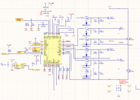rascupanamuha
Member
Hi,
I have designed motor driver for electric scooter. This is my third version of PCB and something is wrong on it and i can't figure out how to solve the problem.
VS on your chip is 12V, and motor voltage is 24V.
If I lower the motor voltage down to 20V, everything works perfectly. At 24V everything is working at lower speeds. When i increase speed, motor doesn't get the power all the time (i have measured voltage between 2 phases, it looks like 50ms motor has normal PWM, and other 50ms motor is free spining generating sinusoidal voltage). But i repeat, i get it working in previous version without a problem, and now i cant figure out. So please help me
I have designed motor driver for electric scooter. This is my third version of PCB and something is wrong on it and i can't figure out how to solve the problem.
VS on your chip is 12V, and motor voltage is 24V.
If I lower the motor voltage down to 20V, everything works perfectly. At 24V everything is working at lower speeds. When i increase speed, motor doesn't get the power all the time (i have measured voltage between 2 phases, it looks like 50ms motor has normal PWM, and other 50ms motor is free spining generating sinusoidal voltage). But i repeat, i get it working in previous version without a problem, and now i cant figure out. So please help me

